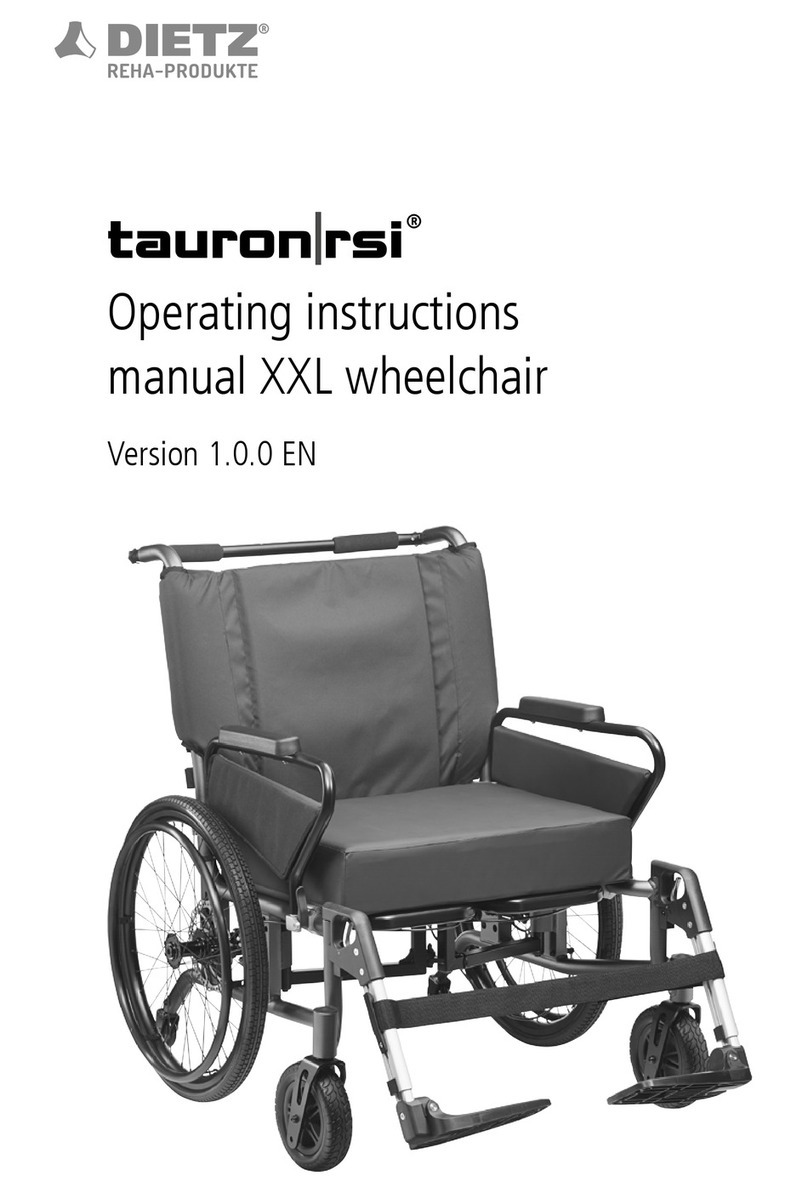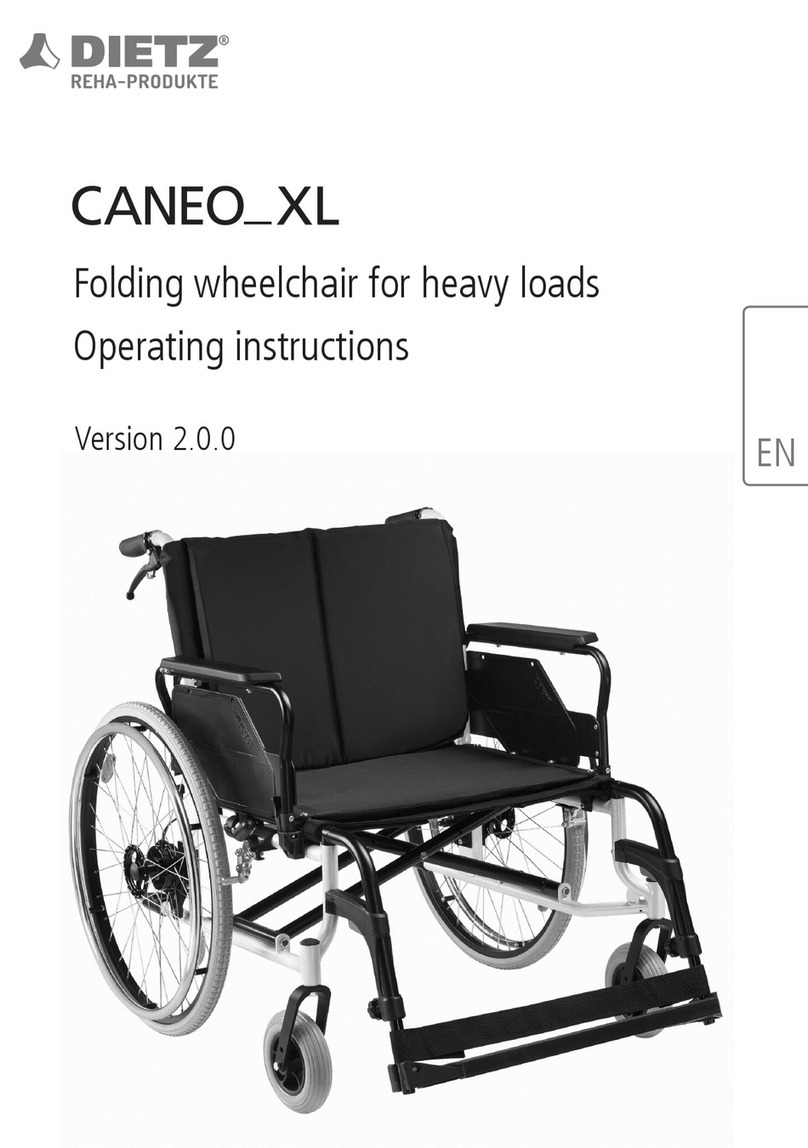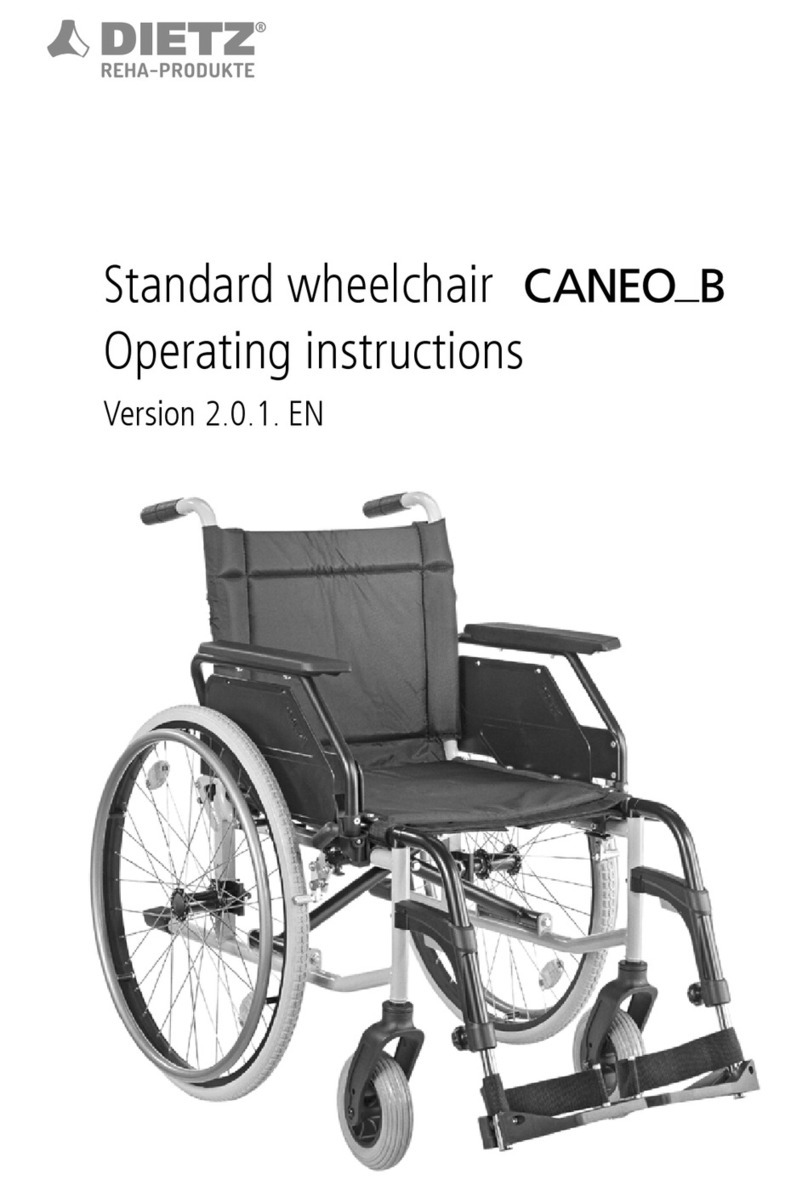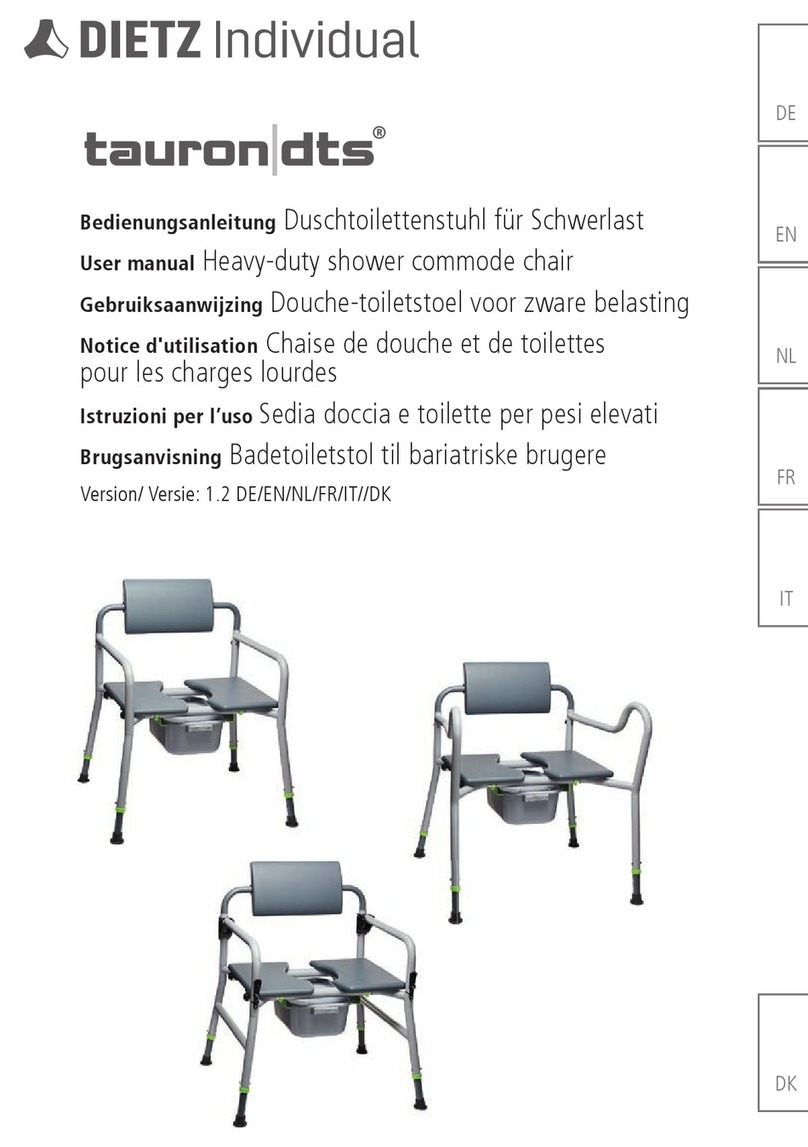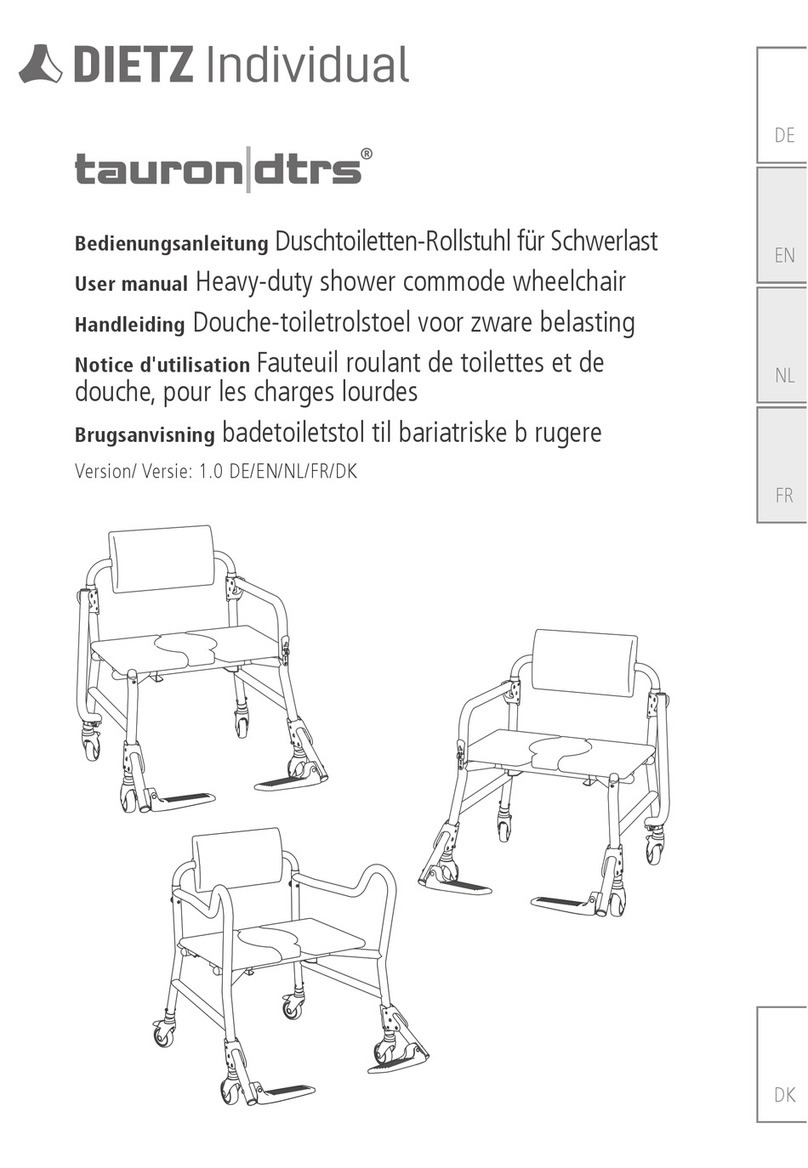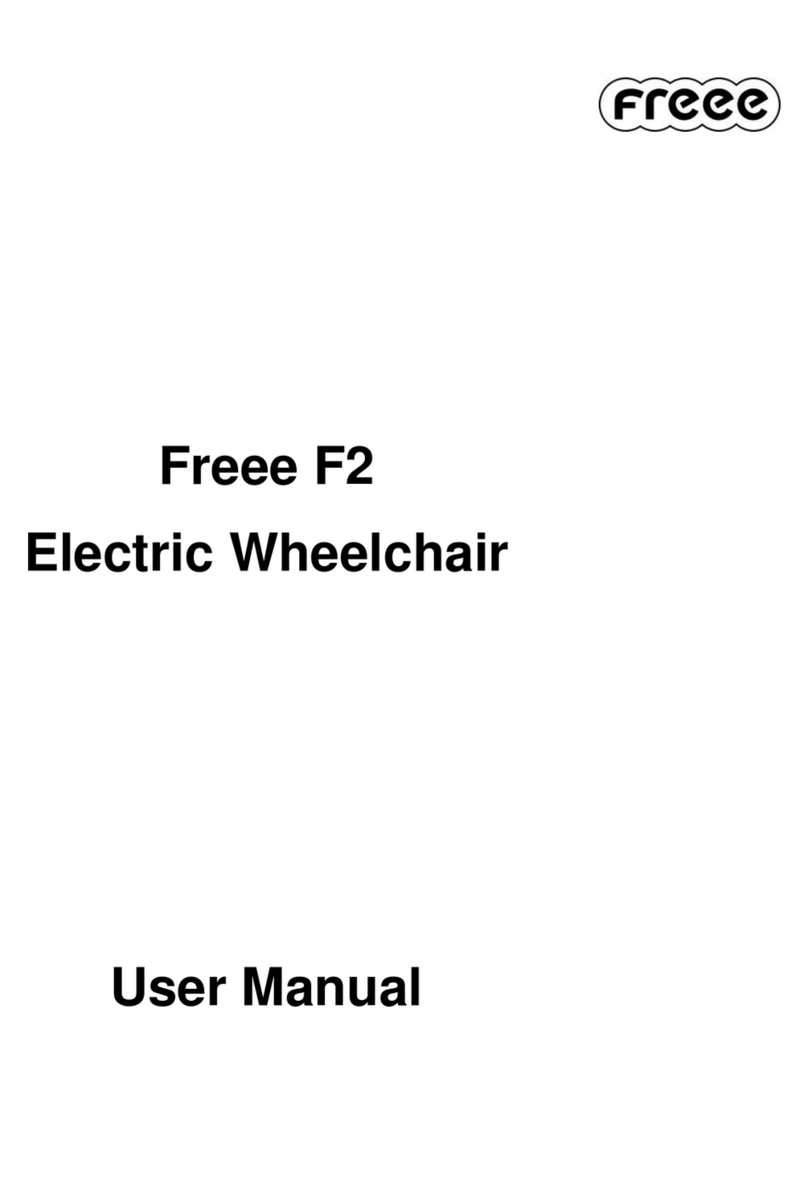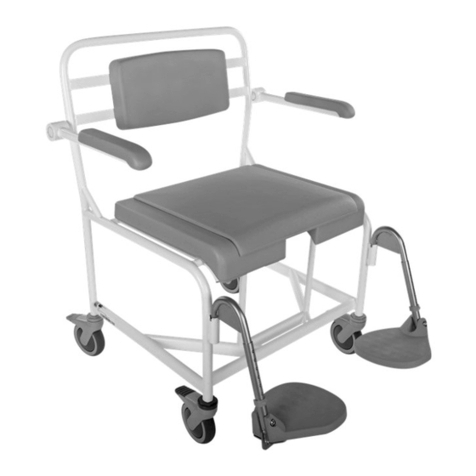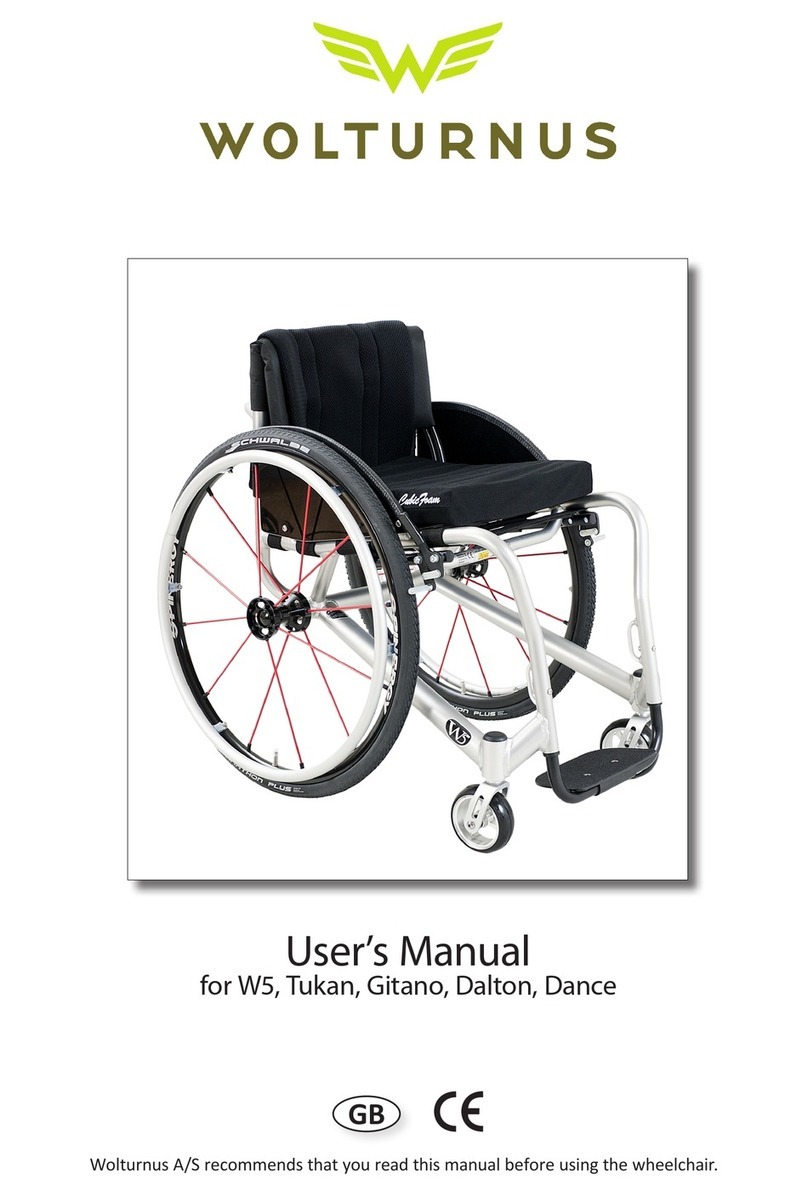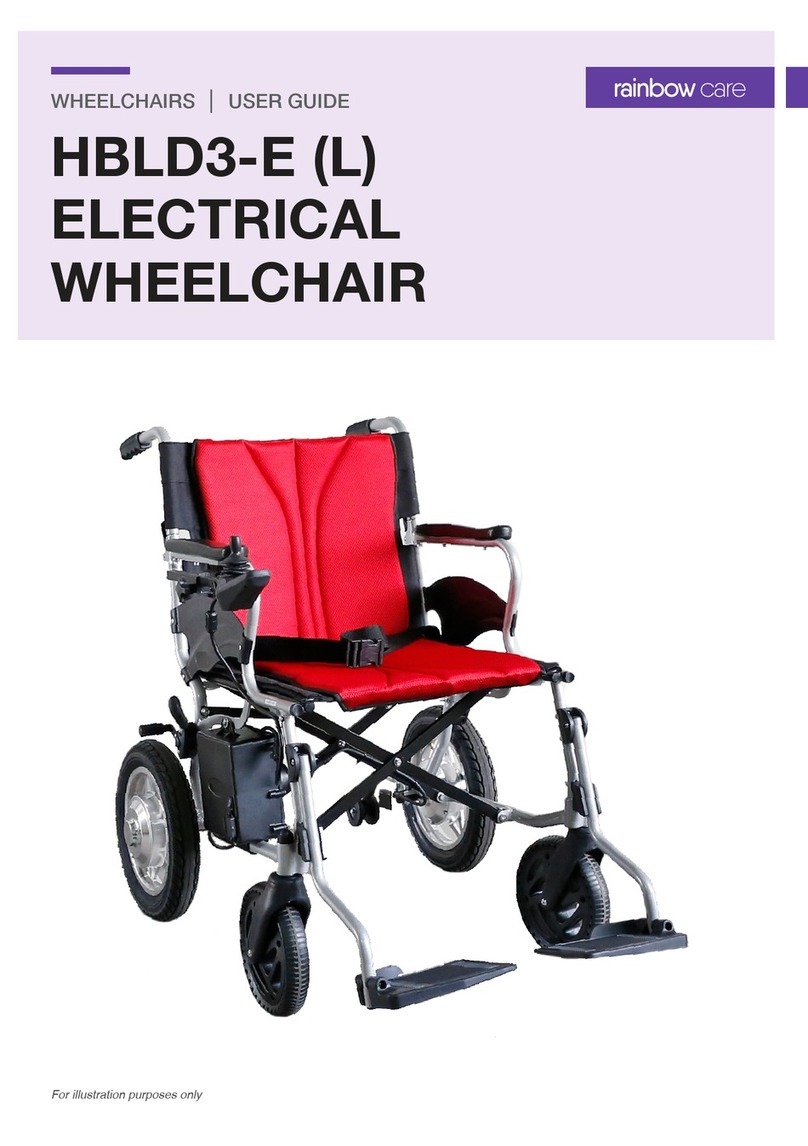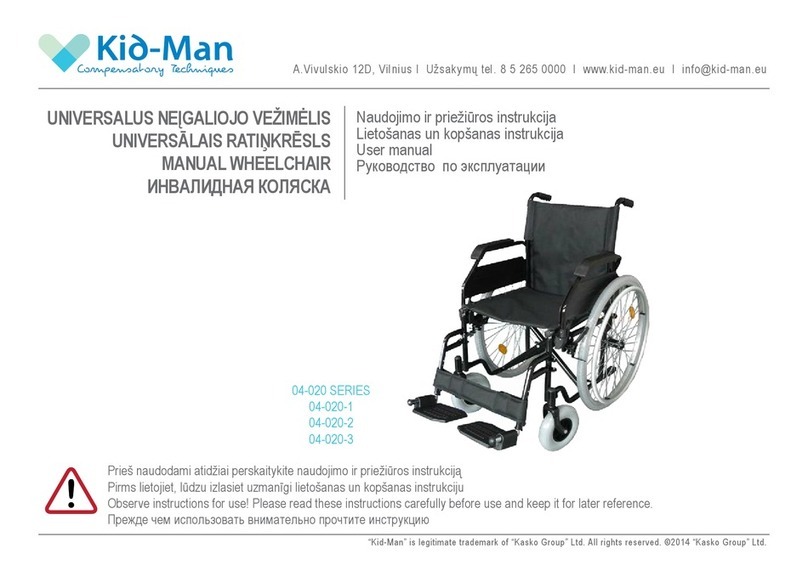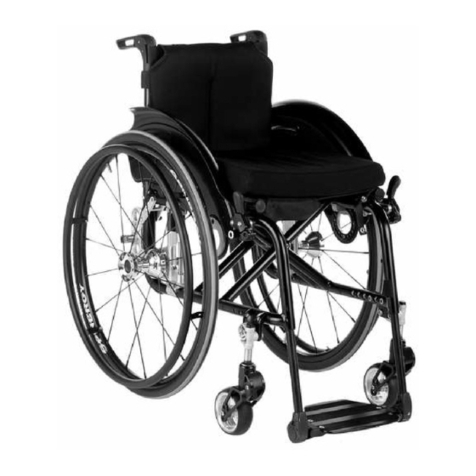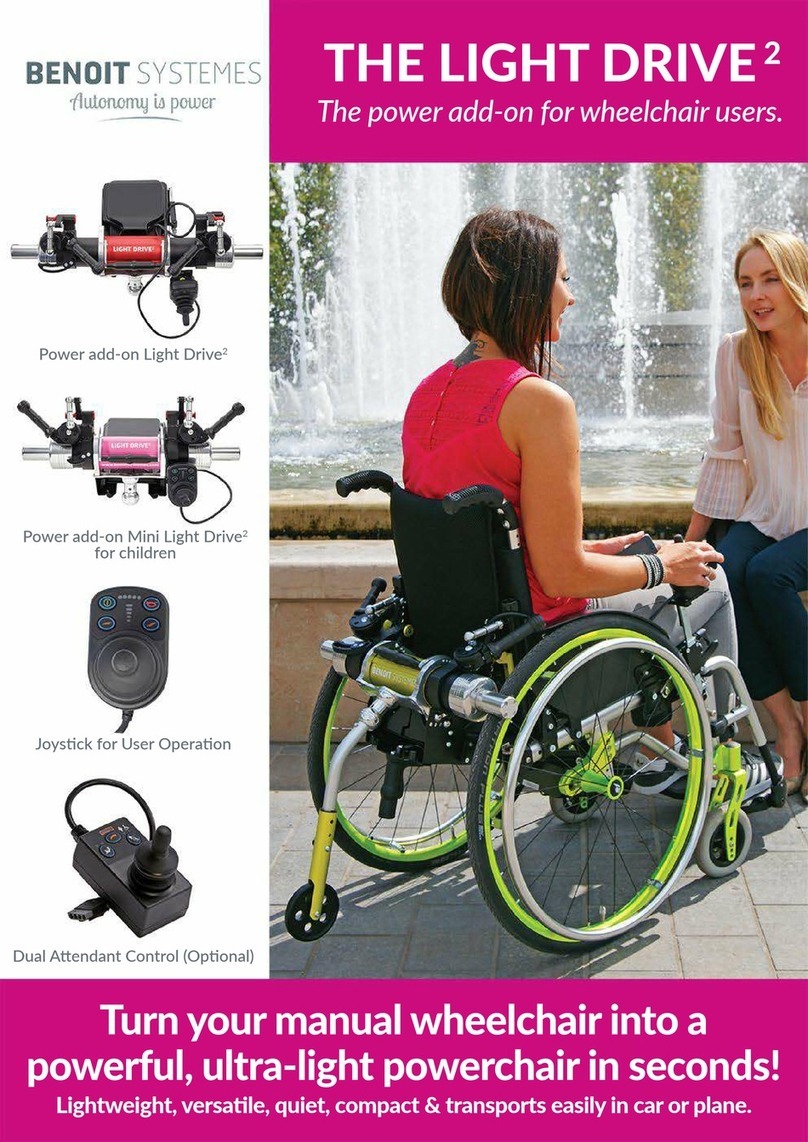Dietz SANGO ADVANCED Series User manual

Sango Advanced R
Sango Advanced F
Sango Advanced M
Sango Slimline M
SERVICE MANUAL

2 - SANGO ADVANCED / SLIMLINE
© 2017 DIETZ-Power BV
All rights reserved.
The information provided may in no way be reproduced and/or published in any
form or by any means (electronically or mechanically) without the express prior
written consent of DIETZ-Power BV.
The information provided is based on general data pertaining to constructions
known at the time of issue. DIETZ-Power BV pursues a policy of continuous
product development and therefore reserves the right to make changes.
The information provided applies to the standard version of the product.
DIETZ-Power BV can therefore not be held liable for any damage resulting from
specications deviating from the standard version of the product.
The information made available has been compiled with the greatest care.
However, DIETZ-Power BV cannot be held liable for any errors in the information
or for the consequences thereof. DIETZ-Power BV cannot be held liable for any
damage resulting from work carried out on the wheelchair by third parties.
Under legislation relating to the protection of trademarks, those commercial
names, trade names, trademarks, etc. used by DIETZ-Power BV may not be
regarded as being free of rights.

SANGO ADVANCED / SLIMLINE - 3
Table of contents
1 Preface ............................................................................................................ 5
1.1. About this manual 5
1.2. Symbols used in this manual 5
1.3. Service, support and ordering 6
2 Safety................................................................................................................ 7
2.1. Safety guidelines 7
2.2. Temperature 7
2.3. Moving parts 8
2.4. Electromagnetic radiation 8
2.5. Markings on the wheelchair 9
3 Maintenance and tools ............................................................................... 10
3.1. Maintenance plan 10
3.2. Tools 11
3.3. Driving programs 12
4 Replacements and adjustments ................................................................ 13
4.1. Preparation 13
4.2. Carrier 13
4.3. Dahl preparation 17
4.4. Interface (all types) 19
4.5. Legrests 20
4.6. Seating system 22
4.7. Control system 22
5 Wiring and diagrams ................................................................................... 23
5.1. Connecting wires 23
5.2. Electrical diagrams VR2 24
5.3. Electrical diagrams R-net 25
5.4. Connect the batteries 26
6 Troubleshooting........................................................................................... 27
6.1. Wheelchair functionality table 27
6.2. Seat adjustments 32
Table of contents

4 - SANGO ADVANCED / SLIMLINE
7 Technical specications ............................................................................. 33
7.1. Standards and requirements 33
7.2. Specications operating force 33
7.3. Specications Sango Advanced Sego Comfort 34
7.4. Specications Sango Slimline Sego Comfort 35
7.5. Specications batteries 36
7.6. Electrical diagrams 36
8 Warranty conditions.................................................................................... 37
8.1. Warranty period 37
8.2. Warranty provisions 38
8.3. Warranty procedure 38
Table of contents

1 Preface
1.1. About this manual
The service manual contains information and instructions about general
maintenance and repairs of the powered wheelchair for:
• Qualied service technicians that perform the maintenance and solves
technical problems of the wheelchair.
• DIETZ-Power dealers who support customers when they call the dealer’s
oce with questions about the wheelchair. This service manual will serve as
reference material to help the customer service employee.
Other available manuals:
• The general user manual of the wheelchair.
• The user manual for the controller.
• The user manual for the battery.
• The spare part manual.
• The technical manual from the supplier of the controller.
Warning!
Read through all the manuals carefully before performing any maintenance or
repairs on the wheelchair. Always follow the safety guidelines!
1.2. Symbols used in this manual
Warning
Follow the instructions given under warnings! Failure to exercise due care in
following these instructions may result in physical injury, damage to the wheelchair
or damage to the environment. Where possible, the warnings are given in the
section that is most relevant.
Cross-reference symbol
Where required, this service manual makes reference to the other manuals. This is
done in the following way:
WHEELCHAIR: Please refer to the general user manual for the wheelchair.
CONTROLLER: Please refer to the user manual for the controller.
BATTERY: Please refer to the user manual for the battery.
SPARES: Please refer to the spare part manual
TECHNICAL: Please refer to the technical manual from the supplier for the
controller.
1 Preface
SANGO ADVANCED / SLIMLINE - 5

1.3. Service, support and ordering
For information concerning specic settings, maintenance or repairs please
contact your supplier. He is always prepared to help you.
Ensure you have the following information at hand (see 2.4 Identication plate):
• Type of the wheelchair
• Year of manufacture
• Identication number
For ordering spare parts please use the spare part manual to see what part
number you need and how to order.
1 Preface
6 - SANGO ADVANCED / SLIMLINE

2 Safety
All of the very latest information relating to product safety and any product recalls
can be found on our website at www.DIETZ-Power.com.
Warning
Follow the instructions given under warnings! Failure to exercise due care in
following these instructions may result in physical injury, damage to the wheelchair
or damage to the environment.
2.1. Safety guidelines
Warning
• We advise you to contact our service department before you do repairs to a
wheelchair that has been involved in an accident.
• Maintenance and repairs may only be carried out by trained and authorised
service technicians. Temporary employees and persons in training may only
carry out repair and replacement work under the supervision of an authorised
service technician.
• Only do maintenance on an empty chair, without user.
• Always make sure that you work safely, particularly when you need to lift up
the wheelchair.
• DIETZ-Power will deliver a wheelchair with default factory settings. These
settings depend on the options ordered with the wheelchair. When a
conguration is ordered that causes interference, DIETZ-Power applies
modied settings.
• Programming should only be conducted by professionals with in-depth
knowledge of wheelchair control systems. Incorrect programming could result
in an unsafe set-up of the wheelchair for a user. DIETZ-Power accepts no
responsibility for losses of any kind if the programming of the control system is
altered without authorization of DIETZ-Power.
• During the execution of maintenance and repairs, the service technician is at all
times fully responsible for the fullment of locally applicable safety.
• After repairing, reprogramming or replacing parts, always check the
functionality of the entire wheelchair. Pay special attention to safety features
such as slowdown driving or drive inhibits when seat lift and tilt are both used.
2.2. Temperature
Warning
• Avoid any physical contact with the motors of the wheelchair at all times. When
the wheelchair is in use, the motors are in constant motion and can reach high
temperatures. Any physical contact with the motors could result in burns. After
use, the motors cool down slowly.
• Ensure that the wheelchair is not exposed to direct sunlight for long periods of
time when not in use. Some parts of the wheelchair (such as the seat, backrest
and armrests) can become hot if exposed to the sun for too long. This may
result in burns or skin sensitisation.
2 Safety
SANGO ADVANCED / SLIMLINE - 7

2.3. Moving parts
Warning
Wheelchairs contain moving and rotating
parts (gure 1). Contact with moving parts
may result in serious physical injury or
damage to the wheelchair. You should
avoid any contact with the moving parts of
the wheelchair.
A. Powered leg rests
B. Swing-away controller arm
C. Powered backrest adjustment
D. Powered tilt adjustment
E. Powered lift adjustment
F. Wheels (turning and pivoting)
2.4. Electromagnetic radiation
The standard version of your powered wheelchair has been tested for compliance
with the applicable requirements relating to electromagnetic radiation (EMC
requirements).
Warning
Despite testing, the following cannot be ruled out:
• electromagnetic radiation interfering with the wheelchair. For example mobile
telephones, large medical devices or other sources of electromagnetic radiation
• the powered wheelchair interfering with electromagnetic elds. For example
shop doors, burglar alarm systems in shops or garage door openers.
• in some congurations equipped with a R-net controller, where it is possible
that extreme electrical discharge situations due to static electricity, may cause
a fault message (‘ISM over-current’) ashing on the screen. If this occurs simply
turn o your wheelchair for a few seconds and back on to clear the fault.
In the unlikely event of such problems arising, please notify your dealer
immediately.
A
F
D
C
BE
1
2 Safety
8 - SANGO ADVANCED / SLIMLINE

2.5. Markings on the wheelchair
Warning
• The markings, symbols and instructions on the wheelchair are part of the safety
features. They must not be covered up or removed. They must remain on the
wheelchair and be clearly legible for the whole lifespan of the wheelchair.
• Immediately replace or repair any markings, symbols or instructions that
become damaged or illegible. Contact your dealer in such cases.
Symbols used on the wheelchair
Consult the manual before
use
Securing point for
transportation inside a
vehicle
A
B
A
B
Freewheel switch
• Drive position
• Push position
Warning
Never set the
freewheel switch
to the 'Push'
position when the
wheelchair is on a
slope.
Warning (yellow-black)
Pinch point hazard: Keep
hands and ngers away
from moving parts when
adjusting the height
and/or tilt angle of the
wheelchair.
CONTROLLER
Battery charging point
Location identication plate:
on the batterybox at the right side
MWD
FWD
RWD
Identication plate
A. Type
B. Year of manufacture
C. Usage indoor or outdoor
D. Manufacturer
E. Maximum load in kg
F. Identication number
2 Safety
SANGO ADVANCED / SLIMLINE - 9

3 Maintenance and tools
General guidelines
• Take all the safety guidelines (2.1) into account when carry out any
maintenance or repairs to the wheelchair.
• Always handle waste materials according to the local regulations.
3.1. Maintenance plan
The wheelcair must be checked by an authorized service technician on regular
basis (at least once a year) and before reuse. Check all parts of the maintenance
checklist and make sure the checklist in the end-users manual will be entirely lled
after each maintenance.
Use only original DIETZ-Power parts for maintenance and repairs.
Operation Chassis
Horn Parts tightened
On/o switch Condition
Output plug Controls
Joystick Upholstery
Brakes Seating system
Programme conguration Backrest
Batteries Armrests
Level Electronics
Connectors Cable condition
Discharge level Connectors
Wheels Driving
Wear Forwards
Pressure Reverse
Bearings Emergency stop
Wheel nuts Turning
Motors Uphill/downhill
Wiring Obstacles
Connectors Parking brake
Noise
Brakes
Remarks:
3 Maintenance and tools
10 - SANGO ADVANCED / SLIMLINE

Batteries
• The wheelchair is tted with ‘dry’ gel batteries. The batteries are fully sealed
and require no maintenance.
• The use of ‘wet’ batteries is not permitted. If the batteries have to be replaced,
use only dry batteries.
• Batteries contain acids. Damaged batteries are a serious health hazard. Follow
the instructions on the batteries at all times.
• WHEELCHAIR and BATTERY for additional information.
• CONTROLLER for the battery wiring diagram
Tyres
Check tyre pressure and inate if necessary
• Before tyres are repaired they must rst be fully deated.
• Never exceed the maximum tyre pressure.
• WHEELCHAIR for the right tyre pressure and additional information.
Wheelchair and upholstery
Clean the wheelchair and its upholstery
• Take care with water in view of the electronic system
• For disinfecting spray the chair with alcohol.
• WHEELCHAIR for additional information.
3.2. Tools
Warning
Use only high-quality tools for the adjustment(s) described.
Tools for mechanical settings
The following tools are needed to do the mechanical settings as described in this
manual:
Description Size* / type
Screwdriver 4x100
Pair of wire cutters
Open ended spanner 10, 13
Ring spanner 10, 13
Torque wrench, up to 60 Nm with
sockets 10, 13
Allen keys 3, 4, 5, 6, 8
Loctite 638 Bolt securing
Loctite 243 Bolt securing
Tie wraps Black
Hammer (plastic)
*Size is the EU key width
3 Maintenance and tools
SANGO ADVANCED / SLIMLINE - 11

Tools for electronic settings
The following tools are needed to do the electronic settings as described in this
manual:
Part
number Description R-Net VR2
PGDT R-Net programmer OEM (D50611) x
PGDT VR2 PC-Programmer B set (D50145) x
Universal meter (voltage and resistance x x
Use the torques as indicated in the table below, unless specied otherwise
Thread Size Pitch (mm) Max. torque (Nm)
M4 0.7 3
M5 0.8 6
M6 1 10
M8 1.25 25
M10 1.5 50
The minimum torque values are 7 - 9 % below the maximum values.
3.3. Driving programs
Excisting driving programs are available on request.
3 Maintenance and tools
12 - SANGO ADVANCED / SLIMLINE

4 Replacements and adjustments
4.1. Preparation
WHEELCHAIR for the most common wheelchair settings (chapter 5).
Warning!
• Take all the safety guidelines (2.1) into account when carry out any
maintenance or repairs to the wheelchair.
• Only do maintenance on an empty wheelchair.
4.1.1. Disconnect the battery and/or
motor connector
For some maintenance the battery
and/or motor connector needs to be
disconnected. There is made a reference
to this action where needed:
1. Loosen the two allen keys of the cover
between the wheels.
2. Open the cover of the power module
3. Disconnect the motor connector (A
gure 2) and/or battery connector (B)
from the interconnection of the power
module.
4.2. Carrier
4.2.1. Replace the rubber suspension
1. Follow the preparation (see 4.1).
2. Unscrew the bolt (A gure 3). Make
sure the battery box will be supported.
3. Replace the rubber suspension (B).
4. Tighten the bolt.
A
B
2
3
4 Replacements and adjustments
SANGO ADVANCED / SLIMLINE - 13

4.2.2. Replace a drive wheel
1. Follow the preparation (see 4.1).
2. Turn o the controller and set both
freewheel switches in ‘Drive’ mode.
3. Lift the wheelchair using a lifting
platform until the wheels are free from
the oor.
4. Remove the wheel cap (A gure 4).
5. Unfold the washer (C).
6. Remove screw B.
7. Remove the drive wheel (D) from the
motor axle. Make sure that you do not
loose the key (E).
8. Install the new drive wheel. Make sure
the drive wheel does not interfere with
the motor.
4.2.3. Replace a motor
1. Follow the preparation (see 4.1).
2. Disconnect the battery and motor
connectors (see 4.1.1).
3. Remove the drive wheel (see 4.2.1).
4. Loosen the screws (A gure 5) to
remove the mudguard (B) for easy
access.
5. Remove the 3 bolts (C).
6. Remove the old drive motor (D).
7. Install the new drive motor.
4.2.4. Replace a castor wheel
1. Follow the preparation (see 4.1).
2. Turn o the controller and set both
freewheel switches in ‘Drive’ mode.
3. Lift the wheelchair using a lifting
platform until the wheels are free from
the oor.
4. Remove the screw, washers and nut (A
gure 6).
5. Take out the old castor wheel (B) from
the castor fork (C).
6. Install the new castor wheel.
7. Use a new lock nut.
A
A
A
A
B
C
A
B
C
D
BA
C
D
E
5
6
4
4 Replacements and adjustments
14 - SANGO ADVANCED / SLIMLINE

4.2.5. Replace a castor fork
1. Follow the preparation (see 4.1).
2. Remove the cap (A gure 7).
3. Unscrew the bolt (B).
4. Remove the castor fork and wheel
from the side frame.
5. Unscrew the bolt and nut (C) to
remove the castor wheel.
6. If needed unscrew the bolt (D) to
remove the mudguard.
7. Mount the new castor fork to the
wheel and mount it back on the side
frame.
4.2.6. Replacing the anti-shimmy
1. Follow the preparation (see 4.1).
2. Remove the cap (A gure 8).
3. Unscrew the bolt (B).
4. Remove the castor fork and wheel
from the side frame.
5. Remove the inner anti-shimmy bush
(C) and replace the rubber rings.
6. Mount the castor fork and wheel back
on the side frame.
4.2.7. Replace an anti-tip wheel
1. Follow the preparation (see 4.1).
2. Turn o the controller and set both
freewheel switches in ‘Drive’ mode.
3. To replace only the anti-tip wheel (A
gure 9): Remove the screw, washers
and nut (B).
4. To replace the complete assembly:
Remove the screws (C).
5. Install the new parts.
A
B
C
A
BB
B
C
A
B
D
C
C
C
C
8
9
7
4 Replacements and adjustments
SANGO ADVANCED / SLIMLINE - 15

4.2.8. Replace the batteries
1. Follow the preparation (see 4.1).
2. Disconnect the battery connector (see
4.1.1).
3. Open the battery cover.
4. Loosen the screws (A gure 10).
5. Loosen the battery Velcro strap (B).
6. Slide the batteries out of the
wheelchair. When 78Ah batteries used,
lift up and slide back the batterybox.
When 78Ah batteries are used, the
batteries will drop down 5 cm.
7. Disconnect the power cables.
8. Remove the batteries.
9. Put the new batteries in the
batterybox.
10. Connect the power cables (see 5).
11. Slide back the batteries into the
wheelchair.
12. Tighten the battery Velcro strap.
13. Close the battery cover.
4.2.9. Replace main fuse
The main fuse is located on the battery
box.
1. Follow the preparation (see 4.1).
2. Remove the caps and the fuse.
3. Put the new fuse in the fuse holder
and put the cap on the holder.
A
A
B
10
11
4 Replacements and adjustments
16 - SANGO ADVANCED / SLIMLINE

4.3. Dahl preparation
Warning!
Dahl car docking is not possible in
combination with 78Ah batteries.
4.3.1. Replace the slider
To mount the Dahl docking plate the
sliders needs to be replaced (side by side).
1. Remove the cables if needed
2. Remove the allen screws (A gure 12)
and battery cover (B).
3. Remove the allen screw (C) and lower
the back part of the seat mounting rail
(D).
4. Remove the allen screw (E), the rail
holder bracket (F). and hex head
screws and rings (G) to remove the
sliders with backrest frame out of the
seat frame.
5. Remove the lighting (H and L), if
applicable
6. Remove the screws and bolts (I) to
loosen the sliders (J).
7. Take the nuts (K) from the old slider
and place them in the new slider.
8. Mount the lighting with the new
(longer) allen screw (L).
9. Mount the sliders and backrest in
reverse order.
4.3.2. Mounting the Dahl locking plate
Warning!
• A crash test with Dahl was performed
on this wheelchair according to ISO 7176-19 (2008) with a dummy weight of 77
kg.
• The Dahl docking station is only allowed to build into a vehicle by trained and
authorized sta of a registered car adaptation company. For ordering the Dahl
docking and its accessories, please contact Dahl Engineering in Denmark for
further details www.dahlengineering.dk.
To mount the Dahl docking station our preparation kit (SPARES 5000062) and
the following Dahl parts are needed:
• 500561 Docking plate (C)
• 502800 High grade steel Torx 27 bolts M8 Quality 14.9 (D)
1. Remove the battery slide plate and the batteries (see 4.2.8).
2. Mount the battery box xation screws 4x (A gure 13).
3. Position the Dahl support plate (B) in the battery box.
4. Mount the Dahl locking plate (C) under the battery box with the special Dahl
nuts (E) and the high grade steel Torx bolts (D) through the Dahl support plate
A
B
C
F
I
J
G
EK
D
H
L
A
B
C
D
E
F
12
13
SANGO ADVANCED / SLIMLINE - 17

and the dedicated holes in the chassis
(gure 14).
Warning!
• The Dahl high grade steel Torx bolts
(D) only come in one length which
is often too long. They need to
be cut into the right length by the
authorized engineer to t the locking
plate properly without damaging the
batteries.
• Do not use any other M8 bolt to
replace 502800. They will not be strong
enough. The bolt length must be such
that they are ush with the upper side
of the hexagon nuts (502186). The
thread may neither protrude beyond
the hexagon nuts or be too short to
achieve their full holding force in the
thread.
5. Add Loctite 222 onto the thread of the
high grade Torx bolts to secure them
and tighten them with a torque wrench
to the preset torque of 16-18Nm
6. Position the two plastic spacers (F) in
the battery slide plate.
7. Place the batteries and the battery
slide plate back in the battery box.
FWD
MWD
RWD
14
18 - SANGO ADVANCED / SLIMLINE

4.4. Interface (all types)
4.4.1. Adjust the centre of gravity
(not recommended)
The position of the interface can be
adjusted in order to give the wheelchair
better driving characteristics. This position
depends on the seat depth and the drive
type.
1. Follow the preparation (see 4.1).
2. Set the interface in the maximum tilted
position for easy access.
3. Disconnect the interface cables from
the controller.
4. Remove the screws (A gure 15) (4x).
5. Move the interface (B) to the desired
new position.
6. Fasten the screws (4x).
7. Check if the wheelchair is stable in all available positions for seat lift and tilt.
4.4.2. Adjust the height of the seat interface (not recommended)
The height of the interface can be adjusted in order to achieve the seat height as
required for the user.
1. Follow the preparation (see 4.1).
2. Remove the srews (A gure 15) to remove the interface including the seating
system from the wheelchair carrier, for easy access.
3. Remove the 2 screws (C) on both sides.
4. Slide the interface bracket into the desired height.
5. Put the srews into one of the 4 holes to and thigthen the screws.
6. Put the interface including seating system back on the wheelchair carrier.
7. Check if the wheelchair is stable in all available positions for seat lift and tilt.
4.4.3. Replace the actuator of the tilt-
only interface
TBD
A
B
C
D
C
15
16
4 Replacements and adjustments
SANGO ADVANCED / SLIMLINE - 19

4.4.4. Replace the tilt actuator of the
tilt/lift interface
TBD
4.4.5. Replace the lift actuator of the
tilt/lift interface
TBD
4.5. Legrests
4.5.1. Replace the actuator of a
powered legrest
1. Follow the preparation (see 4.1).
2. Lift the legrest out of the wheelchair.
3. Remove the tie wraps and disconnect
the actuator cable from the legrest.
4. Remove the screws and bushes (A
gure 19).
5. Remove the old actuator (B).
6. Put the new actuator in the legrest.
7. Connect the actuator cable.
8. Put the connector cable into the
groove of the legrest and fasten the
connector cable with tie wraps.
9. Make sure that you leave enough free
cable length to let the actuator reach
its full length.
10. Check the functionality of the actuator.
A
A
A
B
19
18
17
4 Replacements and adjustments
20 - SANGO ADVANCED / SLIMLINE
Other manuals for SANGO ADVANCED Series
1
This manual suits for next models
5
Table of contents
Other Dietz Wheelchair manuals
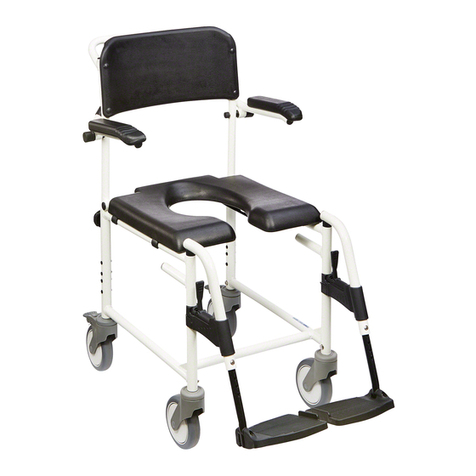
Dietz
Dietz TOMTAR Levina 320-2 User manual
![Dietz AS[01] User manual Dietz AS[01] User manual](/data/manuals/1u/i/1ui1k/sources/dietz-as-01--manual.jpg)
Dietz
Dietz AS[01] User manual
![Dietz AS[01] User manual Dietz AS[01] User manual](/data/manuals/20/j/20jko/sources/dietz-as-01--manual.jpg)
Dietz
Dietz AS[01] User manual
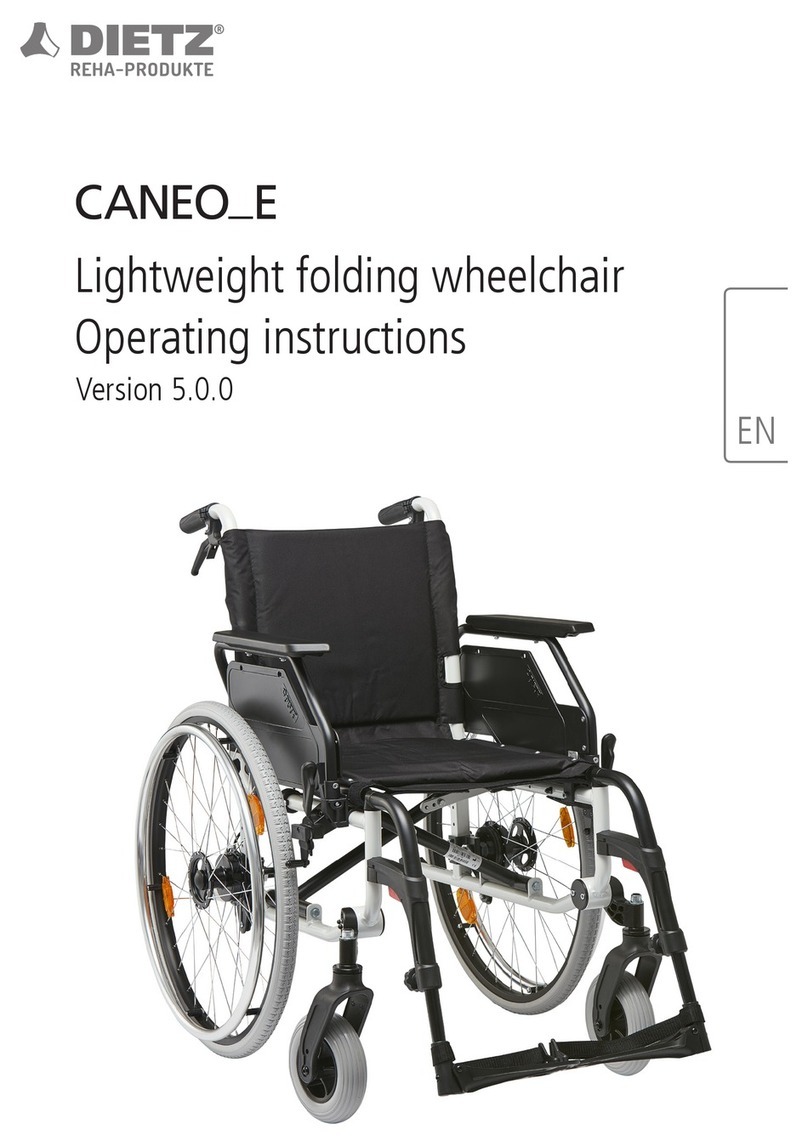
Dietz
Dietz CANEO_E User manual
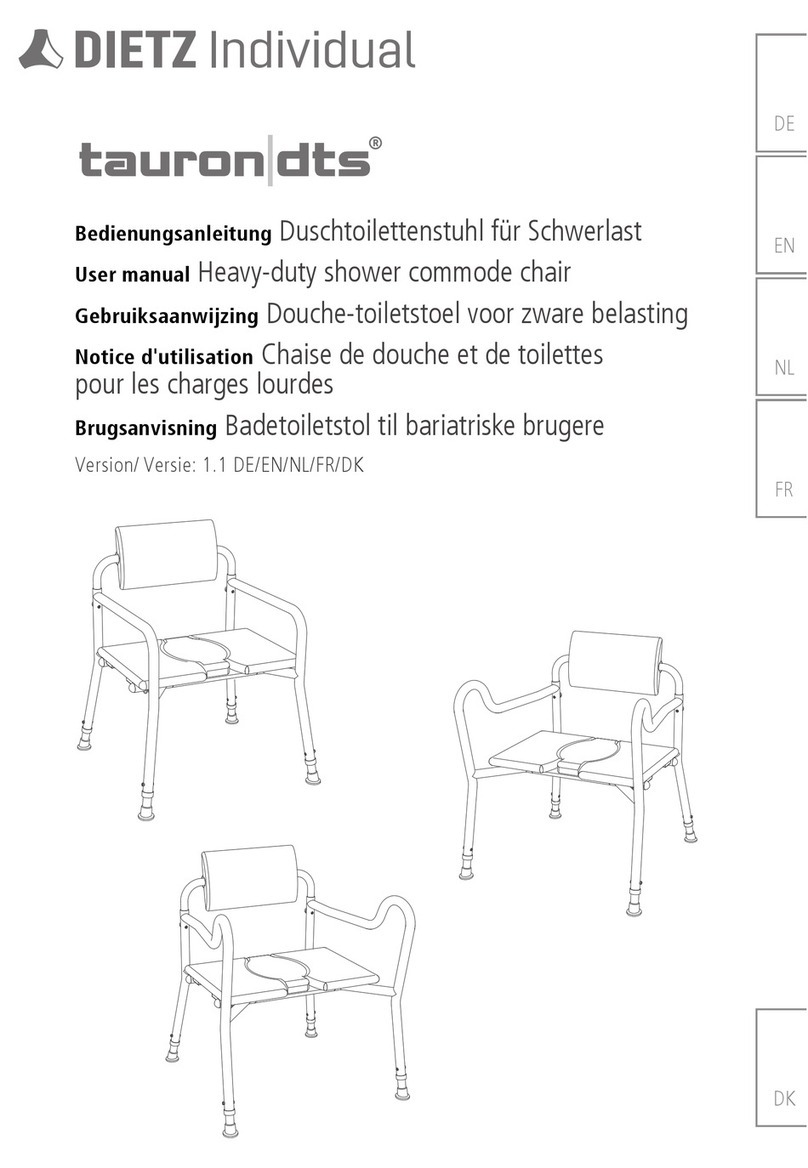
Dietz
Dietz Individual tauron dts User manual
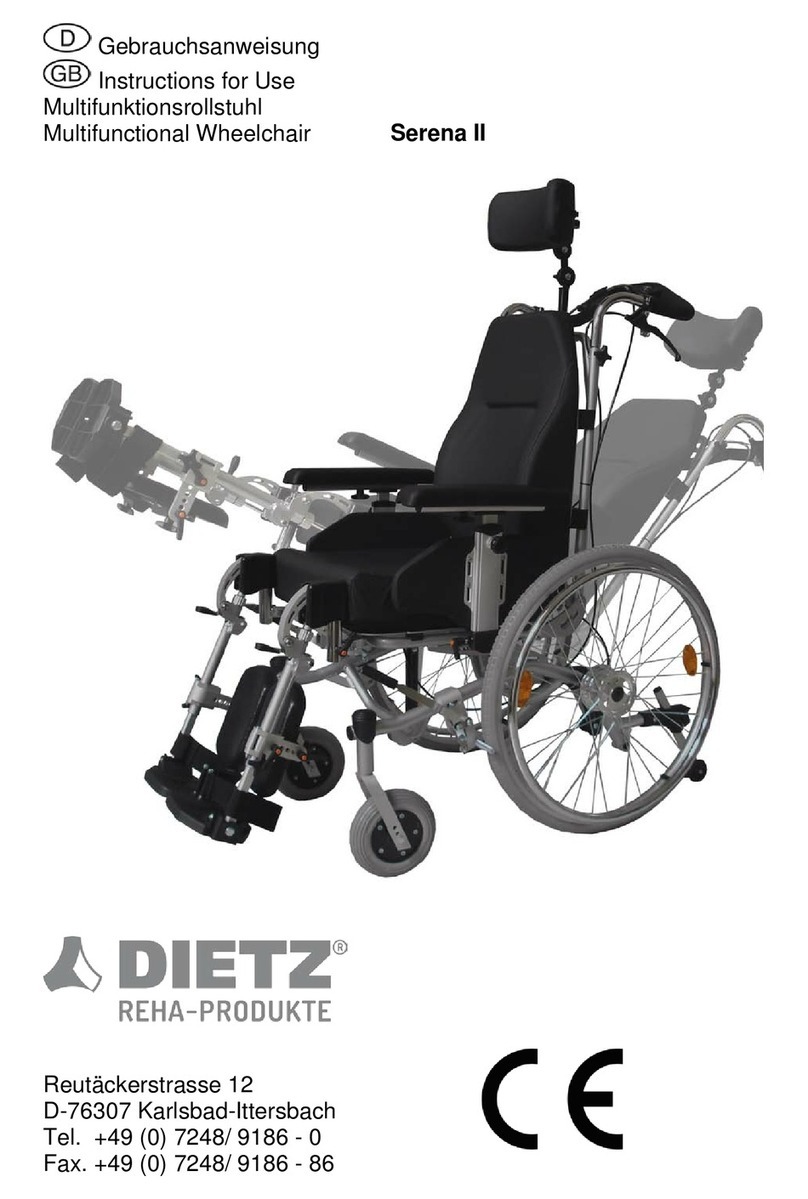
Dietz
Dietz Serena II User manual

Dietz
Dietz TOMTAR Bano User manual

Dietz
Dietz SANGO ADVANCED Series User manual

Dietz
Dietz Caneo 200 User manual

Dietz
Dietz 430101 User manual
